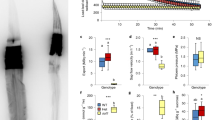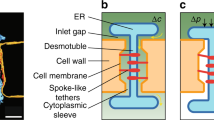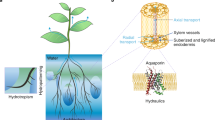Abstract
IT is commonly believed that salts are secreted into the xylem vessels of isolated roots by some mechanism involving metabolic energy and that the concomitant water movement is driven by the osmotic pressure gradient between xylem sap and the external medium. In particular, House and Findlay1 have found quantitative support for this process in maize roots. These workers considered that the exudation from the basal ends of isolated roots was described by:  where Jw (cm3 exuded per cm2 of root surface area per sec) is the fluid exudation rate, LpRT(Csx − Cs0) is the net osmotic water flux from the external medium into the root and ϕw0 is net water flux independent of any osmotic gradient. This latter water flow might possibly be analogous to that found in many animal epithelial preparations bathed in identical salines. In equation (1), Lp (cm/sec atm.) is the osmotic permeability or, more correctly, the hydraulic conductivity of the roots to transverse water flow, R the gas constant, T the absolute temperature, Csx (mole/cm3) the osmolarity of salt (for example, potassium chloride) in the exudate and Cs0 the osmolarity of salt in the external medium. The observed difference in salt concentration (Csx − Cs0) is likely to depend not only on the net salt flux into some compartment, like the xylem, but also on the rate of water entry into this region.
where Jw (cm3 exuded per cm2 of root surface area per sec) is the fluid exudation rate, LpRT(Csx − Cs0) is the net osmotic water flux from the external medium into the root and ϕw0 is net water flux independent of any osmotic gradient. This latter water flow might possibly be analogous to that found in many animal epithelial preparations bathed in identical salines. In equation (1), Lp (cm/sec atm.) is the osmotic permeability or, more correctly, the hydraulic conductivity of the roots to transverse water flow, R the gas constant, T the absolute temperature, Csx (mole/cm3) the osmolarity of salt (for example, potassium chloride) in the exudate and Cs0 the osmolarity of salt in the external medium. The observed difference in salt concentration (Csx − Cs0) is likely to depend not only on the net salt flux into some compartment, like the xylem, but also on the rate of water entry into this region.
This is a preview of subscription content, access via your institution
Access options
Subscribe to this journal
Receive 51 print issues and online access
$199.00 per year
only $3.90 per issue
Buy this article
- Purchase on Springer Link
- Instant access to full article PDF
Prices may be subject to local taxes which are calculated during checkout
Similar content being viewed by others
References
House, C. R., and Findlay, N., J. Exp. Bot., 17, 344 (1966).
Sabinin, D. A., Bull. Inst. Recherche Biol. Univ. Perm, 4, 129 (1925).
Lundegårdh, H., Ark. f. Bot., 31A, 1 (1943).
Arisz, W. H., Helder, R. J., and Van Nie, R., J. Exp. Bot., 2, 257 (1951).
Bennet-Clark, T. A., Plant Physiology, edit. by Steward, F. C., 2, 105 (Academic Press, London and New York, 1959).
Brouwer, R., Acta Bot. Neerl., 3, 264 (1954).
Stadelmann, E., Protoplasma, 57, 660 (1963).
Ray, P. M., and Ruesink, A. W., J. Gen. Physiol., 47, 83 (1963).
House, C. R., and Findlay, N., J. Exp. Bot. (in the press).
Author information
Authors and Affiliations
Rights and permissions
About this article
Cite this article
HOUSE, C., FINDLAY, N. Mechanism of Fluid Exudation from Isolated Maize Roots. Nature 211, 649–650 (1966). https://doi.org/10.1038/211649b0
Issue Date:
DOI: https://doi.org/10.1038/211649b0
This article is cited by
-
Visualisation of xylem sap flow direction in isolated fine lateral roots and estimation of the xylem sap osmotic potential
Biologia plantarum (2012)
-
Movement of solute and water in the cell wall apoplast as a fundamental process for respiration-dependent water transport in higher plants
Protoplasma (1988)
-
A mechanism of respiration-dependent water uptake enhanced by auxin
Protoplasma (1986)
Comments
By submitting a comment you agree to abide by our Terms and Community Guidelines. If you find something abusive or that does not comply with our terms or guidelines please flag it as inappropriate.



